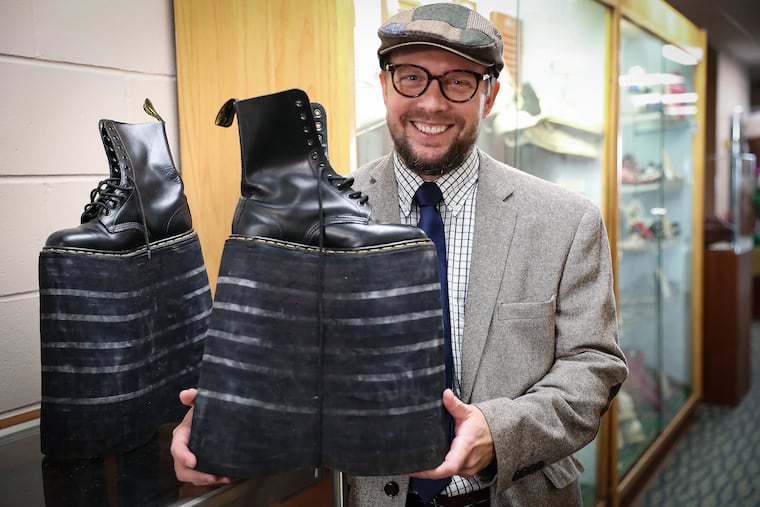Shoegazing at the Shoe Museum: The best finds at one of Philly’s most obscure attractions
The decades-old museum is home to about 1,000 pairs of shoes.

Despite the epic amounts of sole at Philadelphia’s 43-year-old Shoe Museum, foot traffic is sparse. On average, just five to 10 people visit a week.
“It’s not a ton,” said museum curator Andrew Meyr. “I don’t know if we could handle a ton, to be honest with you.”
That’s because the museum is housed in two hallways at Temple University’s School of Podiatric Medicine at 8th and Race Streets in Center City, across from police headquarters.
The Shoe Museum is more of an interesting collection than an immersive museum experience. There are no giant boots to climb through or 3D IMAX movies about penny loafers, just an odd assortment of odd shoes in an odd city.
A city that thought to itself, “We should create a shoe museum to celebrate the country’s 200th birthday."
And then it did.
In 1976, Philly celebrated the nation’s bicentennial in many ways: Charlton Heston emceed a ceremony on Independence Mall, the Liberty Bell got its own pavilion, Queen Elizabeth visited the city.
And the Shoe Museum was created.
Initially a part of the Pennsylvania College of Podiatric Medicine — which merged with Temple University in 1998 — the Shoe Museum was one of several created to celebrate the bicentennial. Others included the African American Museum in Philadelphia and the Mummers Museum.
Meyr, a professor in Temple’s department of podiatric surgery, said the museum has about 1,000 pairs of shoes, 800 to 900 of which are displayed across a dozen exhibits. He remembers passing by the museum as a student at Temple in the early 2000s.
“I’ve always thought it was kind of corny,” he said. “But I also thought that we could make it interesting.”
Many of the shoes were donated but some are on a long-term loan from the Mütter Museum, dating back to 1976.
“When I took over I called the Mütter and honestly I’m not sure they even realized we still had it, given that it was so long ago,” Meyr said.
When he volunteered last year to become the museum’s third curator, Meyr and the museum’s only other staffer — Laura Sansosti, a clinical assistant professor at the school — renovated the museum by shifting its focus from style to function.
Exhibits now include Mummers shoes; shoes used by the military, police, and firefighters; footwear of sporting legends; and shoes of the world.
But why are shoes worthy of their own museum? While some museums include exhibits about shoes, Meyr thinks Temple’s may be the only museum dedicated to shoes in the United States (though there is one in Toronto).
“It’s a fairly universal human experience, right? Any place in the world, any point over time, essentially, we’ve had shoes," Meyr said. “And though that’s fairly universal, it’s also seen as a way for people to express themselves individually.”
Here are some of the most interesting shoes we saw at Temple’s Shoe Museum:
What’s up, Doc?
While the museum has a pair of 6½-inch high-heels that are “too unstable to stand on their own" (we feel you, girl), the tallest shoes in the collection are a pair of Dr. Martens boots with a 12-inch sole.
In those boots, all the world’s a stage. And a diving board.
Meyr said that to the best of his knowledge, the boots were made as a gimmick and not for actual use.
Moonwalkers
The museum keeps a small, “spotlight” exhibit in the main lobby of the school that is currently displaying NASA space boots worn during the Gemini and Apollo missions, as well as a pair worn on the International Space Station.
With the 50th anniversary of the moon landing this year, Meyr wrote to NASA asking if the agency would be willing to lend some space shoes and it happily obliged, even sending a pair of space pressure boots used to walk on the lunar surface.
“They’ve literally been out of this world and on the moon,” Meyr said.
Athlete’s foot
From the ice skates worn by Flyers goalkeeper Bernie Parent during the 1975 Stanley Cup finals to the cleats worn by Mike Schmidt during his final season with the Phillies, the museum’s collection of footwear from local athletes is particularly well curated.
The Converse high-tops worn and signed by beloved 76ers star Julius “Dr. J" Erving are perhaps the most impressive. The sheer size of the sneakers alone is remarkable. If the Old Woman who Lived in a Shoe lived here, she’d be living quite well, indeed.
Meyr said there was no size listed on the shoe. “It is signed and worn and has what looks like an Odor Eater inside, though.”
Lotus misposition
Among the most shocking shoes in the exhibit are the lotus shoes — some measuring as small as 3 or 4 inches long — that were worn by adult Chinese women whose feet were bound.
“It was just social beauty at the time, as barbaric and strange as it seems to us now,” Meyr said of the practice, which began in the 10th century and was outlawed in 1912.
Starting as young as 5, girls would have their feet bound so tightly it prevented normal anatomical development.
“The front part of the foot was pushed down, and then after it went down it was kind of smooshed into the heel, for lack of a better term,” Meyr said. “You could walk, but not far.”
According to material provided by the museum, such tiny feet were considered erotic and “emphasized the wealth of men who could afford such obviously handicapped women.”
“It’s certainly not what we consider from our foot and ankle surgical background a normal, functioning structure,” he said.
Admission to the Shoe Museum is free, but must be scheduled with Meyr in advance. Those interested in touring the museum can email Meyr at ajmeyr@temple.edu. Tours are self-guided with QR codes.